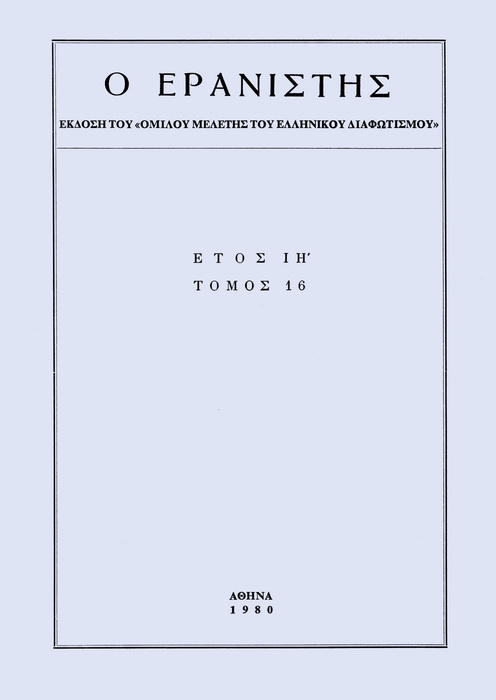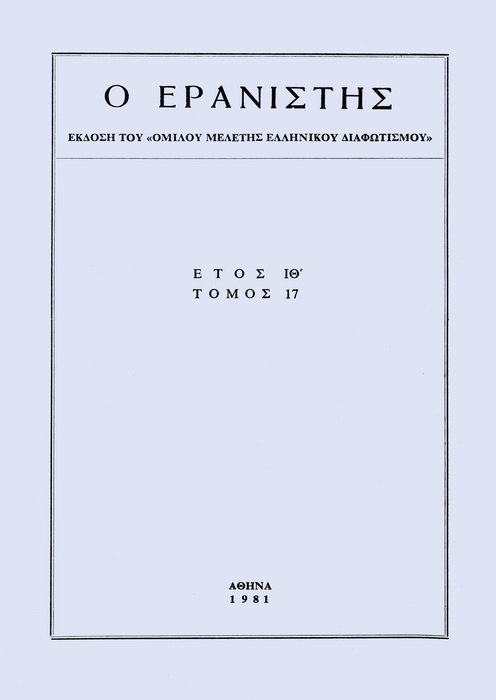Piecing Fragments Together: Recent Evidence about Nikolaos and Konstantinos Karatzas’ Library

Abstract
In the General State Archives, in Athens, specifically in the “Giannis Vlachogiannis” archive collection, there is a file containing seventeen fragments, that are one-sheet, two-sheet, four-sheet and, one among them, five-sheet. Vlachogiannis does not mention anything about their origin; in order to describe, however, the contents of this file, he wrote: “Χειρογράφων αποσπάσματα (βιογραφικά λογίων και κληρικών)” (excerpts from manuscripts (biographical information of scholars and clergymen)). This study aimed initially at tracing the philological identity and origin of these fragments.
The identification of two scribes, who have written the majority of the fragments (fifteen out of seventeen), has given the first clue: Nikolaos Karatzas, a scholar, collector and manuscript scribe all together, owner of one of the biggest libraries in Constantinople in the 18th century, has written eleven texts; in the remaining four, we recognize the handwriting of his son and inheritor of his library, Konstantinos Karatzas. The second piece of information arose from the discovery of the fact that the fragments are not actually fifteen, as textual evidence demonstrated their coherence of content: in fact they form six sections.
But are they indeed excerpts, fragments from “manuscripts”, as Vlachogiannis had assumed?
Evidence from various sources brought forward in this study demonstrate the fact that the fragments were fascicules incorporated into printed books that once belonged to Karatzas' library, probably until the beginning of the second decade of the 19th century.
The printed books in question are the following:
- Meletios Pegas, Ὑπὲρ τῆς χριστιανῶν εὐσεβείας πρὸς Ἰουδαίους ἀπολογία, Léopol 1593.
- Gregorios Palamas, Λόγοι ἀποδεικτικοὶ… [London 1626-1626].
- Ioannes Karyophylles, Ἐγχειρίδιον περί τινων ἀποριῶν…, Monastery of Synagovou 1697.
- Johann Michael Lange, Philologiae Barbaro-Græcæ, Noribergae 1707-1708.
- Ioannes Komnenos, Προσκυνητάριον τοῦ ἁγίου Ὄρους…, Venice 1745.
- Gabriel Severos, Συνταγμάτιον περὶ… μυστηρίων, Venice 1791.
How were these fragments found in Athens, although they originated from printed books located in Constantinople? The answer to this plausible question is that they followed a labyrinthine path: the books that included them were bought by Lord Guilford and were donated to the Ionian Academy, the School he had established in 1824 on Corfu. After Guilford's death, when the books of his library were to be given back to the heirs of the donor, the librarian on Corfu, who was claiming his unpaid salaries, detached the fragments. They remained in the hands of A. Papadopoulos-Vretos and when his archive was sold to the General State Archives in 1920, Vlachogiannis put them aside in order to study them. It should be noted that most of the printed books from which the fragments were detached were bought by the British Museum in an auction, and are today located in the British Library.
DIMITRIS G. APOSTOLOPOULOSArticle Details
- How to Cite
-
Αποστολόπουλος Δ. Γ. (2019). Piecing Fragments Together: Recent Evidence about Nikolaos and Konstantinos Karatzas’ Library. The Gleaner, 29, 89–132. https://doi.org/10.12681/er.21057
- Issue
- Vol. 29 (2016)
- Section
- Μελετήματα

This work is licensed under a Creative Commons Attribution-NonCommercial-ShareAlike 4.0 International License.
The copyright for articles in this journal is retained by the author(s), with first publication rights granted to the journal. By virtue of their appearance in this open access journal, articles are free to use (with the exception of the non-granted right to make derivative works) with proper attribution for non-commercial uses. The Greek Society for Eighteenth-Century Studies (ΟΜΕΔ) retains the worldwide right to reproduce, display, distribute, and use articles published in THE GLEANER in all formats and media, either separately or as part of collective works for the full term of copyright. This includes but is not limited to the right to publish articles in an issue of the Journal, copy and distribute individual reprints of the articles, authorize reproduction of articles in their entirety in another ΟΜΕΔ’s publication, and authorize reproduction and distribution of articles or abstracts thereof by means of computerized retrieval systems









